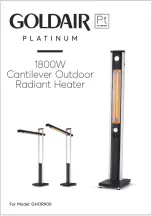
TM081 Rheem 834 Series Hydroelectric CFGWH Service Instructions
REV: AA Issued: 22/02/17
This document is stored and maintained electronically by Rheem Technical Support. All printed copies are deemed uncontrolled.
10
OPERATION
Overview
The heater consists of a gas burner and a copper heat exchanger. When a hot tap is
opened, cold water enters the heater, flows through the heat exchanger and is delivered to
the hot water outlet. Hot flue gases from the burner pass between the fins on the heat
exchanger tube where heat is transferred to the fins and then by conduction into the water
flowing through the fin tube of the heat exchanger. Combustion gasses from the burner
exit via the flue terminal by natural draught where they are dispelled to atmosphere. The
gas supply to the burner from the gas valve is controlled by a temperature controller which
senses the hot water outlet temperature via a temperature sensor and adjusts the gas rate
to the main burner to achieve the desired hot water outlet temperature.
The water heater is activated and deactivated by water flow and a rechargeable 3.7 VDC
battery is utilised to power the water throttle valve and reset the MASV to low fire position
during shut down when there is no water flow through the heater. When water is flowing
through the heater, extra low voltage (1.1 ~ 1.7 VDC) is generated by a hydro electric
generator which is utilised to power the control circuit and recharge the battery.
834 Series Hydroelectric Instantaneous Gas Water Heaters have an interrupted pilot i.e.
the pilot is lit during the ignition period and is extinguished during normal operation of the
main burner.
The following 'Sequence of Operation' and 'Operational Flow Chart' sections detail heater
operation.
Sequence of Operation
Refer to ‘Sequence of Operation Component Diagram’ on page 13 to view components
shown in brackets, e.g.
(1)
if identification is required.
Note: Fault indication referred to throughout this section is indicated by the temperature
controller LED's. For more details refer to 'Operational & Fault Indication' on page 21.
1. When a hot tap is opened, the resulting water flow through the heater causes the
hydro electric generator
(1)
to generate an extra low voltage (1.1 ~ 1.7 VDC). The
water flow sensor
(2)
detects the water flow and sends a pulse signal to the
temperature controller
(3)
that is proportionate to the water flow rate through the
heater. Operation past this point will not occur unless the water flow rate is > 3 L/m.
2. If water flow rate through the heater is > 3 L/m, as determined by the water flow sensor
(2)
pulse rate, the temperature controller
(3)
initialises, illuminates it's green LED and
drives the MASV (Motor Actuated Solenoid Valve)
(4)
to the minimum opened
(minimum gas rate) position. Note: No gas is let through to the main burner
(5)
as the
main gas train solenoid valves SV2
(6)
and SV3
(7)
are not yet energised.
3. The ignition module
(8)
is energised and performs a check for false flame via the flame
sensor
(9)
. If a false flame is detected (> 0.5 µA
for ≥ 3 seconds), fault indication is
provided and the heater will not operate until it has been reset (hot tap turned off and
then turned back on) at which time the heater will restart from step 1. Operation past
this point assumes a false flame has not been detected.
4. The ignition module
(8)
supplies high voltage pulses to the ignition rod
(10)
which arcs
(sparks) across the gap between the ignition rod and the pilot
(11)
hood. SV1
(12)
is
energised which allows gas to travel to the pilot which is ignited by the ignition rod
spark.











































